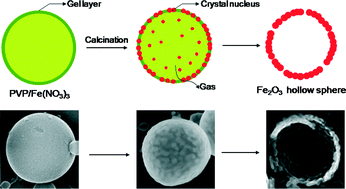Electrospun hollow cage-like α-Fe2O3 microspheres: synthesis, formation mechanism, and morphology-preserved conversion to Fe nanostructures†
Abstract
Hollow cage-like α-Fe2O3 microspheres with an average diameter of 500 nm and a shell thickness of 60 nm were successfully synthesized by a simple electrospinning technique using ferric nitrate (Fe(NO)3·9H2O) and polyvinylpyrrolidone (PVP) as precursors. Fe(NO)3/PVP composite microspheres were calcined at high temperature to form an interconnected 3D hollow cage-like α-Fe2O3 structure. X-ray diffraction (XRD), field emission scanning electron microscopy (FESEM), high-resolution transmission electron microscopy (HRTEM), and magnetic measurements were used to characterize the morphology, structure, and magnetic properties of α-Fe2O3 microspheres. Based on the characterization results, a formation mechanism for electrospun hollow cage-like α-Fe2O3 microspheres was proposed. We also found that morphology-preserved conversion from α-Fe2O3 to magnetic Fe can be achieved during reduction reactions in H2/Ar. The magnetic property investigation showed that the as-prepared hollow Fe nanostructures exhibit a ferromagnetic behavior and possess high saturation magnetization (Ms).


 Please wait while we load your content...
Please wait while we load your content...